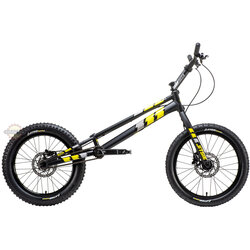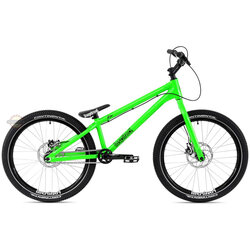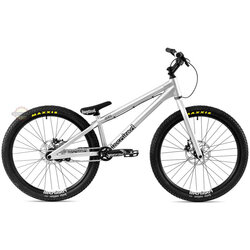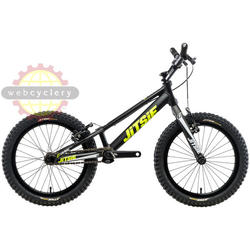About Bike Trials
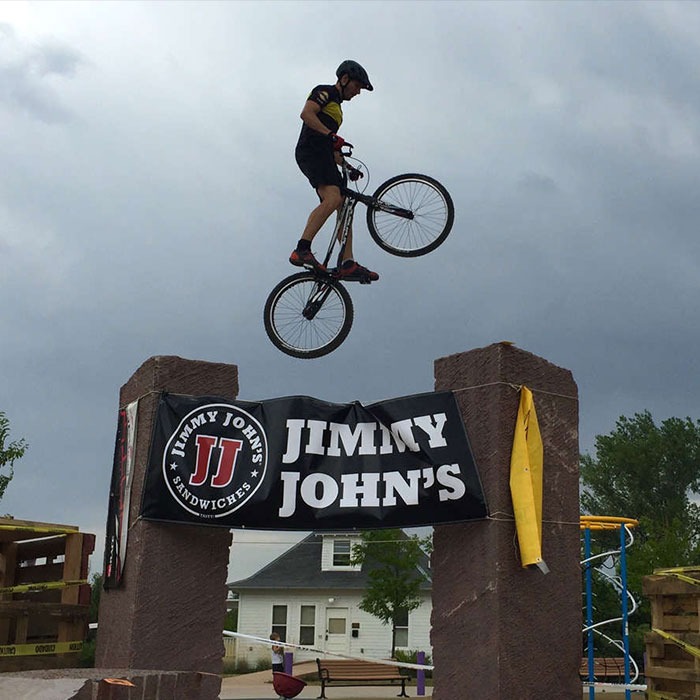
Author: Ross Winsor, Webcyclery pro trials rider and 5x US National Champion
Last updated: June 2023
Your Bike Trials Questions Answered
We're proud to be the biggest trials dealer in the US. We import Echo, Inspired, Trialtech, Jitsie, Crewkerz, Racing Line, TNN, and many more trials brands.
We also have more trials bikes, frames, and parts than anybody in the country. We have a real brick and mortar shop, with real mechanics, real tools, and real inventory.
As you might expect, we get a lot of questions about bike trials. We've created this Bike Trials guide to answer some of the most common questions people have when first exploring the sport.
What is a trials bike?
A trials bike is a bicycle designed specifically for trials riding. They look different than BMX and mountain bikes because they are purpose built to excel in the demanding sport of bike trials which requires maximum agility, strength, and balance.
Some people refer to this discipline as mountain bike trials in order to differentiate the sport from its motorized counterpart, but here at the shop and in the industry we just say trials bikes (the bicycles) and bike trials or just trials (the sport).
What are the best trials bike brands?
Shop our selection of trials bikes & parts from brands like Inspired Bicycles, Jitsie, and Echo.
Do I Need a Trials Bike to Learn Trials?
It’s not necessary to have a trials-specific bike to learn trials. Many riders first start out on a modified hardtail mountain bike or dirt jumper. As long as the brakes work well and the bike is in good working order, you’ll do just fine learning the basics.
Putting the seat all the way down and using a fairly low gear also helps. That said, a trials bike will make learning the basics easier. The trials-specific geometry and construction makes for a stronger bike that's easier to maneuver.
A trials bike will make your new venture into trials riding much more enjoyable. Additionally, once you’ve mastered the basics, a trials-specific bike will allow you to progress to bigger and more advanced moves and techniques. For a detailed explanation of trials bike geometry and how it differs from other bikes, check our Bike Trials Geometry Guide.
What size trials bike should I get? Mod vs. Stock vs. 24"
Mod bikes are the smaller 20" wheeled bikes. These can be easier to learn on, especially for younger riders, as the smaller wheels and frame are lighter and more maneuverable. Mods are generally shorter, bouncier and have a more playful feel overall. Stock bikes use 26" wheels like your mountain bike. They’re bigger and often a little heavier than mods, but the big wheels mean they’re better for rolling over obstacles and they tend to feel more stable.
As you might expect, 24" bikes are somewhere in-between, although they tend to trend more toward 26”. They are gaining popularity and many riders prefer them because they have advantages of both wheel sizes; the wheels are big enough to easily roll over obstacles, but at the same time, they are shorter and more playful than stock bikes.
One of the most common questions new riders have when contemplating buying a trials bike is "what size trials bike should I get?" A lot of choosing wheel size is personal preference. That said, in general, taller riders often feel more comfortable on 24” or 26” bikes and smaller riders may prefer 20” bikes.
Another deciding factor may be the rider’s background. BMXers will usually feel more comfortable on 20” wheels while someone with mountain bike experience might find 26” wheels more familiar. All in all, it comes down to what feels comfortable. There are tall riders that prefer mods and short riders that like stock bikes. The best way to find out what bike feels best is to ride different trials bikes if you have other riders in your area.
Riding Styles: Street vs. TGS vs. Competition
Street
Due to the blending of trials and BMX by riders such as Danny MacAskill and the rise in popularity of companies such as Inspired, street trials has quickly become its own distinct style of trials riding. Street trials combines elements of BMX and street riding with trials moves, giving it a faster, more flowy style than pure trials.
Street trials bikes typically have seats and less extreme geometry than pure trials bikes. They are often a good option for someone getting into trials because they feel more like a normal bike than other types of trials bikes. More recently, brakeless street trials has also gained a small but dedicated following.
Learn More About Street Trials Bikes
TGS
TGS stands for Tap, Gap, Sidehop and is used to describe a style of trials riding that is mainly performed in urban areas. It tends to focus on going as high or as far as possible and is usually less creative and dynamic than street trials.
Dropgaps (a gap where the landing is significantly lower than the takeoff) also feature prominently in this style of riding. It emerged and is still most prevalent in the U.K., due in part to the concentration of cities and urban riding opportunities there. TGS bikes are often heavier and more durable than other bikes so that they can take the stress the riders put on them.
Competition
Competition style riding is, as you might expect, a style of riding used primarily by riders who compete in trials events. Competition riding focuses on using efficient technique and form with as little wasted energy as possible. Riders practice very technical and precise moves that are often required in competitions.
Comp style riders usually prefer light bikes that are as efficient as possible at getting them through a section in competition. Competition bikes usually bear the least resemblance to normal bikes both in geometry and appearance. Comp style riding and TGS are less distinct from one another than from street trials, and sometimes there is little difference between the two.
These different styles are constantly evolving and riders are frequently blurring the lines between different styles. Many talented riders can ride street trials lines on a comp bike or vice versa. And of course there are riders who may not fall under any of these styles.
Street Trials
TGS
Tire Pressure
Proper tire pressure for trials can be subjective and highly dependent on the tires being used. Higher pressure will reduce the risk of pinch flats but decrease grip and bounce. Lower pressure will increase grip but may make the tire more prone to pinch flats and rolling on the rim.
Generally, for pure trials, you want to run as low pressure as possible for maximum grip without pinch flatting or rolling the tire. A good starting point is about 25psi. As you ride let about 1psi out every 10 minutes or so and see what pressure feels good to you.
Street trials generally requires higher pressure than pure trials due to the nature of the riding and the tires typically being used. Tires used for street trials usually have thinner sidewalls than pure trials tires and as such, require higher pressure to remain stable and avoid pinch flats.
Additionally, the higher speed, more BMX type moves frequently used in street trials are often easier with less rolling resistance, which can be achieved with higher tire pressure. 30-35psi is a good starting point for street trials bikes.
Trials Gearing
Another common question is what gear should I run? Like many aspects of trials, it is somewhat personal preference and can also be dependent on what type and brands of components are used. Trials bikes usually have lower gearing than other single speed bikes such as mountain bikes and dirt jump bikes.
Typical gearing for pure 26” trials bikes is 18-15 (18t in the front and 15t in the rear). Many 24” pure trials bike are spec’d with 18-14 while 20” bikes commonly have 18-12. 18t is a common size for the front because most modern pure trials bikes use a front freewheel threaded to the crank and 18t is the most common trials freewheel size.
Because street trials often incorporates moves and lines with more speed, gearing for street trials bikes is usually a little higher than a pure trials bike. Typical street trials gearing is 22-18 for 26” and 22-16 for 24”.
Rim Grinding
Trials riding requires powerful brakes that lock well. A common practice in trials to improve rim brake performance is rim grinding. This is accomplished by using an angle grinder to rough up the braking surface of the rim. This gives trials bikes with rim brakes their distinctive loud braking sound.
Grinding a rim effectively gives the brakes a more on/off feel, with less modulation. This means the wheel locks up better and the rider has more control. It does sacrifice brake modulation though, meaning slowing down or feathering the brakes is more difficult.
Many people wonder if grinding will wear out a rim. The short answer is yes, it can. But in reality it takes many grinds to take enough material off the sidewall to actually weaken it. If done properly, grinding does not remove very much sidewall material at all, it merely roughens up the surface of the rim.
Trials rims can vary in sidewall thickness, but most have fairly thick sidewalls that are designed with grinding in mind. New riders may worry about grinding through the sidewall of the rim, but as long as you don't let the grinding disc rest in the same spot too long, it is nearly impossible for this to happen.
The most likely way for grinding to damage a rim is when the rim has been ground many times and the sidewall becomes thinner and more prone to denting. In reality though, trials riders will often taco a wheel or break spokes or otherwise damage the wheel or rim in some other way before a rim ever gets weak from grinding.
What Length Stem Should I Run?
Most importantly, stem length is personal preference. There are some general guidelines with bike and rider size, but in the end, it comes down to what feels comfortable.
Typically, taller riders will feel more comfortable with longer stems while shorter riders will prefer shorter stems. As trials frame geometry has evolved and bottom brackets have gotten higher, longer stems are being used more prevalently.
A higher bottom bracket places the feet higher in relation to the rest of the frame and bike, so a longer/higher stem must be used to compensate and place the hands in the same position relative to the feet.
20” bikes use longer stems because of their smaller size. Stem lengths for mod run from 145mm-180mm. Typical stem lengths for 24” and 26” bikes are more variable and can run anywhere from 120mm-165mm. An exception to these measurements is younger riders who need a shorter stem to make the bars easier to reach. If possible, it’s best to experiment with different stem lengths to see what feels most comfortable with your setup.
Street trials bikes use shorter stems than pure trials bikes. A shorter stem allows street trials bikes to be more maneuverable at speed and easier to spin. A slightly longer stem on a street trials bike will be more comfortable when on the rear wheel while a shorter stem will be generally better for bunny hops and spins. Typical stem lengths for street trials range from 80mm-110mm.
Shop Trials Bike Handlebars, Grips, & More
Front Freewheel vs. Freehub
Most pure trials bikes made today have a fixed rear hub and a front freewheel that threads onto the crank. This has some benefits: first, it’s less expensive than a traditional hub with enough engagement for trials, such as a Chris King.
It can also be slightly lighter depending on the components used. Additionally, it removes weight from the rear wheel and puts it closer to the rider’s center of gravity, which makes it easier to maneuver the rear wheel during certain moves.
Many riders still run traditional freehubs with quick engagement such as Chris King, Hope or Hadley. Freewheels typically will not last as long as freehubs, but they’re much cheaper to replace when they do break. Once again, there is no best setup, just subtle differences between the two.
Rim Brakes vs. Disc Brakes
Another very common question is what type of brake is best: disc or rim? In reality, neither one is best, each has advantages and disadvantages. Rim brakes, both hydraulic and vee, generally have a more on/off feel with not much in between. In other words, they have less modulation than disc brakes. This on/off braking is very desirable for many situations in trials when you need to the wheel to be completely locked on an obstacle.
A powerful brake that locks well gives the rider more control and precision. Disc brakes have a smoother, more progressive feel. They can be feathered to provide just the right amount of power where and when it’s needed. This is especially useful for moves such as manuals or nose wheelies. Some riders also prefer disc brakes because they’re relatively silent, whereas rim brakes generally make quite a bit of noise, particularly with a fresh grind. Rim brakes are generally lighter than disc brakes, and this is one of the reasons they’re prevalent on many competition bikes.
A common setup on some trials bikes is to have a front disc brake and a rear rim brake. This gives the rider excellent locking power for the rear wheel and the ability to slow down and modulate using the front brake. Dual disc brakes are common on 20” bikes because the smaller wheels can be locked up easier with standard size rotors. Disc brakes are also most common on street trials bikes where the extra modulation is beneficial.
What Should I Learn First?
Beginners often wonder what techniques they should start learning first. We won’t go much into the “how to” aspect of learning any particular moves, as there are many very good resources for this elsewhere online such as Trashzen. The most basic move in trials is the trackstand, simply balancing in one place with the bike. It is a building block for many other trials skills, as well as being very useful in any type of cycling.
There is no set order in which to learn trials skills, but it’s generally a good idea to start with trackstands and get proficient at them before moving on to more advanced moves. After you’ve mastered the trackstand, you can move on to hopping in place on two wheels and moving the front wheel back and forth and moving the rear wheel back and forth while trackstanding. Many riders equate trials riding with being on the rear wheel, and much of modern riding does involve rear wheel moves, but for beginners, it’s usually good to get proficient at balancing and hopping on two wheels before trying rear wheel moves.
Having a solid base of balance and maneuvering on two wheels will make learning rear wheel moves easier and safer in the long run. For a more complete explanation and tutorial check out these two excellent resources for beginners wanting to learn the basics of trials riding: Your Complete Guide to Trials Riding by Julien Happich and Mastering the Art of Trials with Ryan Leech.
Where Else Can I Learn About Bike Trials?
There are many other online resources with information about bike trials. To find out where you can learn more about bike trials, check out our Bike Trials Links page. And if you're ready to give trials riding a try, check out our extensive online catalog where you'll find everything you need to get started.

